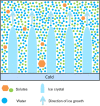Winter is coming: the future of cryopreservation
- PMID: 33761937
- PMCID: PMC7989039
- DOI: 10.1186/s12915-021-00976-8
Winter is coming: the future of cryopreservation
Abstract
The preservative effects of low temperature on biological materials have been long recognised, and cryopreservation is now widely used in biomedicine, including in organ transplantation, regenerative medicine and drug discovery. The lack of organs for transplantation constitutes a major medical challenge, stemming largely from the inability to preserve donated organs until a suitable recipient is found. Here, we review the latest cryopreservation methods and applications. We describe the main challenges-scaling up to large volumes and complex tissues, preventing ice formation and mitigating cryoprotectant toxicity-discuss advantages and disadvantages of current methods and outline prospects for the future of the field.
Keywords: Biostasis; Cryobiology; Freezing; Organ banking; Vitrification.
Conflict of interest statement
The authors declare that they have no competing interests.
Figures




References
-
- Love R. Chillin’ at the symposium with Plato: refrigeration in the ancient world. ASHRAE Trans. 2009;115:106.
-
- Boyle R. New experiments and observations touching cold. London: J. Crooke; 1665.
Publication types
MeSH terms
Substances
Grants and funding
- 614629/ERC_/European Research Council/International
- EP/S001433/1/Engineering and Physical Sciences Research Council of the United Kingdom
- 208375/Z/17/Z/WT_/Wellcome Trust/United Kingdom
- RPG-2016-015/WT_/Wellcome Trust/United Kingdom
- BB/R014949/1/BB_/Biotechnology and Biological Sciences Research Council/United Kingdom
LinkOut - more resources
Full Text Sources
Other Literature Sources

